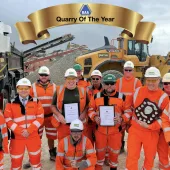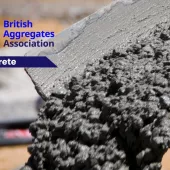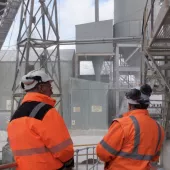BAA Annual Conference 2017

First published in the August 2017 issue of Quarry Management
Part two of QM’s report on the British Aggregate Association’s conference seminar proceedings
We have all read reports in newspapers about 40,000 people a year dying as a result of diesel emissions and how cities are now working towards banning the vehicles we were previously encouraged to buy. Replacing diesel cars, vans and lighter lorries in cities with petrol-electric cars and hybrids might be an option, but it is not yet a practical alternative to diesel-powered plant in quarries. But you can burn greener diesel.
One of those greener alternatives is Green D+, and Kevin Mahoney, who set up Weybridge-based Green Biofuels in 2013 to make Green D+, went along to the British Aggregates Association (BAA) annual conference at the Forest of Arden Hotel, in Warwickshire, in June to explain how quarry operators could benefit from using it.
The fuel is made by adding a patented nanotechnology performance additive (based on cerium oxide) to hydrotreated vegetable oil (HVO) – a renewable diesel. Green Biofuels buy their HVO from Neste, a major supplier of renewable diesel that promotes its fuel as ‘the highest-quality diesel in the world’.
According to Kevin Mahoney, Green D+ delivers at least the same performance as regular diesel (often 10% or more better) but can cut greenhouse gas emissions by as much as 90% (if the fuel is derived from a qualifying waste). On a pair of 175kVA generators running at 70% load, Green D+ (compared with gas oil) reduced nitrous oxide (NOx) by 27%, 10-micron particulate matter (PM10) by 75% and PM2.5 by 84%.
The fuel is distributed in the same way as regular diesel (and can even be mixed with regular diesel), uses the same tanks and pumps, and copes with low temperatures and storage in the same way as regular diesel. In fact, it will last longer in the tank and gives better fuel stability than red diesel. It is even price competitive with regular diesel (thanks to government subsidies), as the price of HVO is coming down.
Mr Mahoney started the morning’s cameo presentations, with the BAA conference taking its now established format of giving the morning’s speakers 15 minutes each to make their major points, which helps keep the presentations focused.
In the afternoon there are longer presentations. This year they included an inspirational presentation lasting about an hour-and-a-half by Lord Digby Jones, a former director-general of the CBI and former government Minister for Trade & Investment (see last month’s issue of QM for further details).
Kevin Mahoney’s presentation was one of several that addressed environmental issues. It is a subject quarry operators have learnt not to ignore if they expect to secure future planning permissions on this crowded island. But at the same time, environmental organizations have come to understand the important contribution minerals extraction makes to the creation of otherwise disappearing wildlife habitats.
Nothing demonstrates the co-operation that has developed between the minerals extraction industry and environmental champions more than Nature After Minerals (NAM), which is now celebrating its 10th anniversary and has been supported by the BAA since its inauguration.
Helen Barnard, who joined NAM as a programme manager in December last year, although she had worked closely with it since its formation, spoke about NAM’s biodiversity-led mineral restorations that have benefitted nature as well as providing people with some delightful sites to visit and enjoy.
Jim Davies from the Environment Agency, Victoria Bankes Price from the Woodland Trust and Peter Dorans from The Wildlife Trusts were also all positive about the contribution minerals extraction and business in general is making to environmental conservation.
By working with these organizations to protect the environment, the industry’s irreplaceable contribution to the built environment and the wider economy becomes better understood and more widely appreciated.
Jim Davies now works with the Environment Agency’s National Planning Team with specific responsibility for the planning and permitting interface and pre-application advice. He represents the EA on the UK Minerals Forum and played an important role in the EA’s engagement with the Government’s ‘Cutting Red Tape’ review of the minerals sector.
He said that whatever taking back control the UK might do as a result of Brexit, planning laws would not go away, even if some red tape was removed. They would not even change for some time. He said early engagement with the Environment Agency would remain key for minerals companies.
He explained the new structure of the Environment Agency, divided into 14 areas and married up with Natural England, and spoke specifically about permitting changes for dewatering, which are expected to go live before the end of the year. He presented some case studies involving water issues: North Yorkshire Potash Mine; ‘Drakelands’ tungsten mine in Devon; and ‘South Crofty’ tin mine in Cornwall, where there are plans to restart production.
Victoria Bankes Price joined the Woodland Trust as planning advisor in 2011 and leads its work on national planning policy. She has spoken at a BAA annual conference previously and said she felt she had been given a hard time by an audience who seemed to consider her ‘a bit of a tree-hugger’. This time, she said she hoped to dispel that impression, although as there was no time for questions from delegates at this year’s event, whether she succeeded or not can only be surmised.
The key aim of the Woodland Trust, which is an independent charity, is to protect ancient woodland, although it also likes planting new woods. Because mineral deposits are sometimes under ancient woodlands, the Trust can come into conflict with the minerals extraction industry and construction projects. However, she said the Trust does not engage with NIMBYs who try to use it to oppose planning applications.
Peter Dorans manages the interface with business of 47 independent Wildlife Trusts with 800,000 members. ‘What sits behind us? Really, it’s the recognition of what nature does for us – and does it for free. For example: bees. By pollenating plants, they save agriculture between £400 million and £600 million a year.’
He spoke of some of the nature projects that companies had been involved with, but the thrust of his afternoon (ie longer) presentation was the part natural environments can play in helping people recuperate or cope with illness, including mental illness – and he said a third of everyone alive today would be suffering some kind of dementia by the time they died. People suffering or recovering from any illness feel ‘substantially healthier’ when they interact with nature, said Mr Dorans.
The Wildlife Trusts, in co-operation with 50 other organizations, produced a report last year looking at the state of nature in the UK. It was not doing well, with many species endangered. However, a significant contribution to conservation in the past 20–30 years had been the creation of wetlands and nature reserves in old minerals workings.
Although environmental issues played a big part in this year’s BAA conference, other issues were also addressed, notably training.
Training – or the lack of its provision by British companies, especially independent companies – was something Lord Digby Jones later complained about in his conference-concluding presentation.
He said companies were reluctant to train people who then went to work for someone else. In fact, showing a level of interest in staff by providing training is more likely to retain them. Lord Jones said productivity has to improve if the UK is to compete in the world and make the most of Brexit, and training is an essential element of increased productivity.
BAA members at the conference had previously heard about the training on offer from John Wilkinson, chief executive of the Mineral Products Qualification Council (MPQC); Mike Phillips from the Institute of Quarrying; and Mark Osbaldeston and Julie Stone from the University of Derby’s Centre for Mineral Products.
John Wilkinson became the chief executive of the MPQC at the end of 2015 after 30 years in the industry with RMC and CEMEX. He said when he started in the industry, in his first two years as an assistant quarry manager he had seen two dead bodies in the company’s quarries. ‘It had a profound effect on me and that sort of incident had a profound effect on the industry.’ That is why the industry had to become more professional.
He said MPQC’s 218 members employ 33,000 people. The MPQC consists of three sectors: MP Futures (setting standards); MP Awards (maintaining standards); and MP Skills (delivering training and assessment).
Lord Jones would also go on to decry the inadequacy of schools dumping innumerate and illiterate 16-year-olds into the workplace, but John Wilkinson explained how MPQC is addressing that by helping people to become STEM Ambassadors.
STEM stands for science, technology, engineering and maths. There are now more than 30,000 STEM Ambassadors from all sectors of industry between 17 and 70 years old. They come from 2,500 companies. They are volunteers who use their time, enthusiasm and experiences to encourage and inspire young people to achieve more and progress further in the STEM subjects.
Mr Wilkinson said informal education could be useful, but it is not until people are tested for their competencies that you can really be sure they have learnt the lessons. That is why it is important they should obtain vocational qualifications (VQs). And there is now an App from the MPQC that employers can use quickly and easily to check that prospective employees have the VQs they claim.
The Institute of Quarrying (IQ) has always championed training and continues to do so, as general manager Mike Phillips explained. He works closely with MPQC.
He told the conference that on 19 October 2017 IQ will be 100 years old. To celebrate its centenary it had built a show garden at the Royal Horticultural Society’s first flower show at Chatsworth House in June – and won the Best Show Garden Award.
Inscribed on a arch in the garden was the IQ motto: Terram autem fillis hominum – Earth is given to the children of men. The motto is intended to remind quarry operators of their responsibility to preserve and optimize the usage of land while protecting the environment.
Mr Phillips told the BAA about the IQ Prime Project, which, working with industry suppliers and contractors, puts in place CPD for operatives in the industry at an appropriate level for them. The move followed the introduction of a new ‘Technician’ grade of IQ membership for operatives. Prime Project had been developed in partnership with the MPQC to create a careers path for operatives and achieve Target Zero.
‘It really works,’ said Mr Phillips, so now comes Prime Site, Prime Supplier and Prime Contractor. He explained how Prime Site had worked at Banks Mining’s Shotton site, and how a certain amount of initial scepticism had turned into enthusiastic support for the programme.
Then there is the University of Derby with its Centre for Mineral Products, headed by Mark Osbaldeston. He and a colleague, Julie Stone, who is director of the university’s online learning, told BAA members about the range of courses available for the minerals industry from the university. Everything from short courses to a Level 7 MBA are run through the Centre for Mineral Products.
As well as the courses at the University of Derby itself, a range of online courses is now available, which opens the university and a UK qualification to overseas students without them having to travel to Britain. ‘Our ambition is to be the UK’s leading online university,’ said Ms Stone.
There is even an online MBA with sector-specific modules in a framework approach. It is intended for people who already have a good honours degree, who the university would expect to complete the course in 24–36 months. Ms Stone said existing leadership experience could also be considered as an entry point into the programme.
One area where many people hope to see less bureaucracy after Brexit is health and safety, even if there is a reluctance to say so too openly. Cath Pickett, an inspector with the Health and Safety Executive since 2001 and the lead inspector with the BAA and Aggregate Industries UK, used a case study from the 1930s as a response to those who had asked her where are all the cases of silicosis if respirable crystalline silica (RCS) is so dangerous.
The case study comes from a book, ‘The Hawk’s Nest Incident – America’s worst industrial disaster’, which can still be purchased.
The Hawk’s Nest tunnel is in West Virginia. It was dug as part of a project to dam and divert a river for the benefit of a Union Carbide steel plant. Many of the people working on the tunnel were immigrants who are not even recorded. It is known that 700 people died during the construction as a result of silicosis, but there were probably a lot more than that.
The tunnel had no forced ventilation and the workers were not given masks. Drilling was carried out dry because it was quicker than wet drilling. The danger of silica was understood and the level in the dust was measured – levels as high as 94% (RCS) were recorded. Some of the workers died within weeks of entering the tunnel and many became too ill to continue working once the project was completed.
The packed programme at the BAA conference also included presentations by Mark Oldridge, managing director of Mineral Surveying Services, and Rupert Craven of Ritchie Brothers, the auctioneers.
Mr Oldridge talked about fracking. He said in 2015 coal had accounted for the largest single part of electricity generation in the UK (30.8%). A year later it was 15.8%, with gas having taken over the top spot at 37.8%. Nuclear was less than 20%, renewables 25%. That is the background against which shale gas exploration is taking place. In America it is making a lot of cheap electricity.
He explained how shale gas is recovered and where it is being investigated in the UK on 6,000km2 of licensed land. He did not believe there was a problem of the gas entering aquifers but said there could be earthquakes. He asked the BAA members if they would be happy to have a shale gas extraction plant near their home. Not many hands went up. He concluded: ‘To frack or not to frack? You decide.’
Rupert Craven used the evidence of what Ritchie Bros is selling at auction as an indication of market trends in quarrying equipment. One trend was clear: the weak pound was making used plant being sold in the UK popular around the world. And Ritchie Bros auctions are online these days as well as taking bids from people at the auction site in Donnington, so the sales are international.
It was certainly a packed programme – so packed that the start time had to be brought forward half an hour to 10am to squeeze it all in. There was also a small exhibition for BAA members to look at during coffee and lunch breaks, with stands from CEM Solutions, Command Alkon, Country Computers, Energi Mine, Herbst Software, Mitsubishi Electric, Netwatch, North Dean Engineering and SERAC, as well as organizations represented by some of the speakers.
And, just to keep it cosy for the BAA members who sat down for 2h of AGM after the conference seminar proceedings, the air conditioning in the hotel had given up the battle with the temperature outside (and inside) topping 30°C.
- Subscribe to Quarry Management, the monthly journal for the mineral products industry, to read articles before they appear on Agg-Net.com







